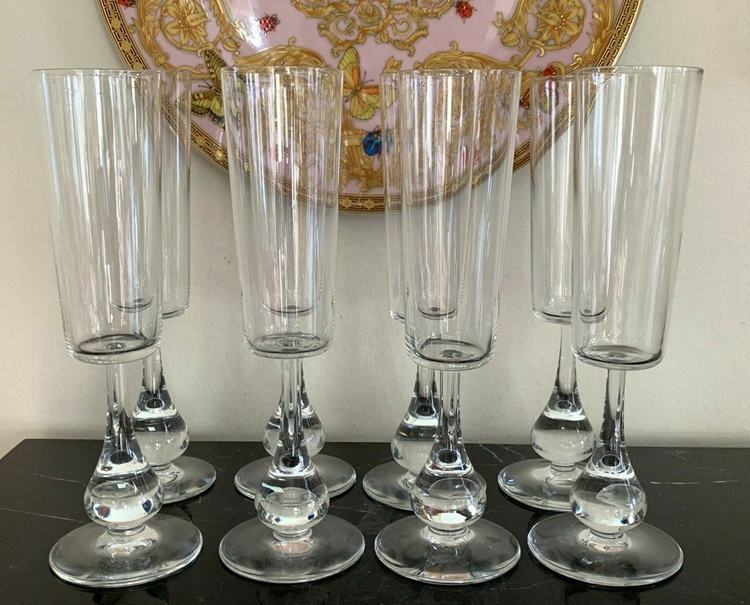
Vintage crystal is one of the most valuable types of vintage glass. Clear glass with intricate patterns differentiates it. We’ll go over all you need to know about spotting vintage crystal patterns in this blog.
If you want to learn about t
he various types of crystal patterns, how to recognize them, and how to date a crystal item, we are here to help you!
Table of Contents
The History of Crystal Glass Patterns
Crystal patterns have been around for a long time, with many of the earliest forms dating back to medieval times.
George Ravenscroft was granted a patent for clear crystal glass in 1673, establishing the first industrial manufacture of diverse crystal items.
Although geometric designs were often manufactured, religious or allegorical themes were prevalent in this type of crystalware.
Following his discovery, other industries in England began to imitate and perfect his product, resulting in Crystal glassware being immensely popular among customers at the time.
Despite the prosperity Crystal glassware brought to England’s economy, the government saw an opportunity to raise taxes on Crystal glassware manufacturers.
As a result of the high taxation, most British producers relocated to Ireland to avoid paying exorbitant taxes, and Ireland became the headquarters of Crystal glassware.
Some communities, such as Waterford, benefited greatly from the glassware business, particularly since the valuable Waterford glass factory was constructed there in the 18th century.
Regardless, the Irish government viewed the industry’s success as an opportunity to levy large taxes on the Crystal glassware producers, forcing some enterprises out of business since they couldn’t keep up. And there’s more. Various Crystal glassware firms did not continue operations after WWII.
This aspect enabled other Crystal glassware makers from various nations to rapidly expand their operations.
By the nineteenth century, nations such as Italy, Sweden, and France had established themselves as among the world’s greatest Crystal glassware makers.
Baccarat, Swarovski, and Orrefors began to prosper during this period. It’s important to understand that lead oxide may be found in a variety of Crystal glassware.
Crystal glassware has a maximum percentage of color, hardness, brightness, sparkle, and weight of 24.
Crystal glassware is highly sought out due to its rarity and value of 24 percent. Collectors are continually amazed when they come across this form of Antique Crystal Glassware.
Patterns of Vintage Crystals
Antique crystal patterns come in a variety of styles and designs, each having its motif and design. As a result, compiling a complete collection of historical crystal designs is challenging.
The following are some of the most popular antique crystal glass designs:
- American Clear
- Capri
- Wexford
- Harmonie
- Rose Point Clear
- Massena
- Longchamp
- Thistle
- Navarre Clear
- King Edward
- Gallia
- Flame D’Amore
- Carina
- Kylemore
- Kildare
- Perfection
Famous Antique Crystal Manufacturers
To determine the worth of your Crystal glassware, you must first learn about the creator, as certain firms are more valuable than others.
From the 18th through the 19th centuries, here are some well-known Crystal Glassware manufacturers:
Fostoria Glass Company
From 1887 through 1986, this corporation was in operation. It is well-known for producing high-quality Crystal glassware. It was founded in Fostoria, Ohio.
Baccarat Company
This is a well-known French producer who is still well-known today! Since 1764, the firm has been producing high-end glassware.
Its trademarks include molded markings, etchings, and one-of-a-kind labels with the words ‘baccarat’ and France’ appearing around the circumference of these glasses. A magnifying lens may be used to examine the etched design.
Crystal Waterford
In 1783, this firm was the first to produce Crystal glassware. To recognize the etched markings on the labels of this brand.
Gorham Manufacturing Company
This corporation was founded in Rhode Island. It originated as a silverware industry but subsequently made Crystal glassware in 1831.
The Lenox Company
The firm was founded in 1889 and mostly makes beautiful Crystal glassware printed with distinctive labels and logos.
Heisey
This firm was founded in the 1890s and ceased operations in the 1950s, making Crystal glassware extremely rare. An ‘H’ mark was one of their most recognizable insignia.
How To Date Antique Crystal Patterns?
To properly date old crystal designs, search for a few indications. Remember that crystal glass was created for decades, if not centuries, thus establishing the exact era of manufacturing is difficult if the piece lacks official documentation.
However, there are a few factors you may consider to determine the age of a crystal glass piece:
Glass
The crystal glass itself should be the first thing you look at. Early crystal pieces were commonly produced using leaded glass.
Those pieces were heavier and has a less distinct brilliance and color than later crystal pieces made of lead-free soda-lime glass, which became popular towards the end of the nineteenth century.
Pattern
During various historical periods, some patterns were more popular than others. However, it is too broad for this post to describe, therefore you should always contact an expert who can predict the date merely by examining the pattern.
Manufacturer
Most items are imprinted with the maker’s mark, and if you’re lucky enough to have one, you may look up when that manufacturer was in business online.
How Can You Identify a Vintage Crystal Pattern?
One of the most important tasks is identifying the pattern of antique crystal glassware, just because there are many.
Furthermore, because most designs were produced by many organizations, slight variations exist even in well-known patterns.
If you’re lucky, you could find the pattern name embossed anywhere on the piece, but this wasn’t common practice, and it’s far more difficult to identify a design if it isn’t printed on the item.
So, while determining the design of a crystal object, it is always preferable to use a reference book or an internet database.
The Hobnail Pattern
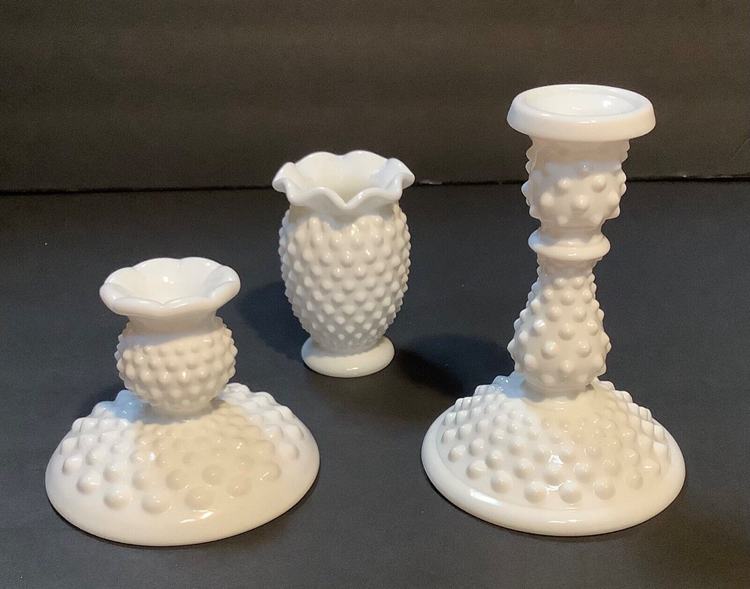
The surface of the glass has so-called “hobnails,” which are little raised bumps. The design generally begins with larger hobnails that gradually become smaller.
Several prominent businesses, like Imperial, Hobbs Brockunier and Co Fostoria, and Westmoreland, produced this design throughout the Victorian era.
The Daisy And Button Pattern
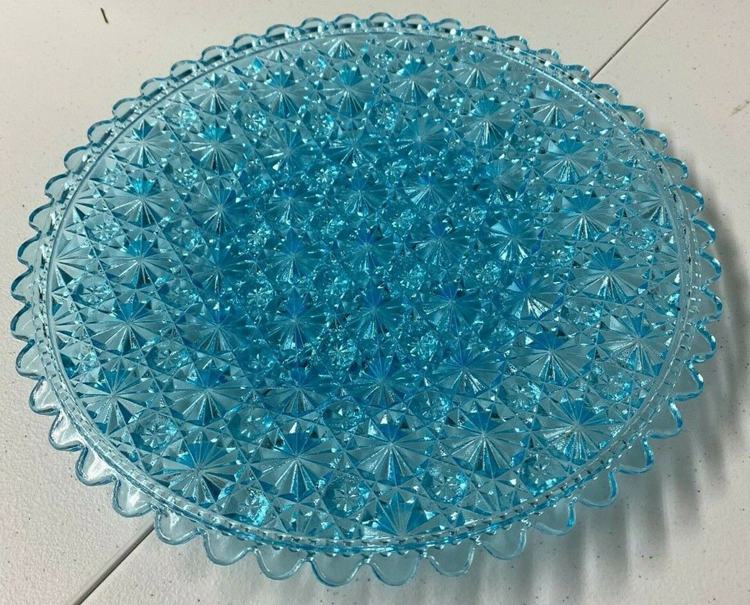
This is a popular design that has a daisy blossom motif formed by little dots placed in a shape. The “daisies” are repeated in the same way throughout the composition.
This design was manufactured by practically every crystal glass manufacturer, therefore it was quite popular, and each manufacturer had its unique spin on it. It became so popular that Hobbs Brockunier & Co simply referred to it as “Pattern 101.”
Other well-known companies include Imperial, Fostoria, and Westmoreland.
The Diamond point Pattern
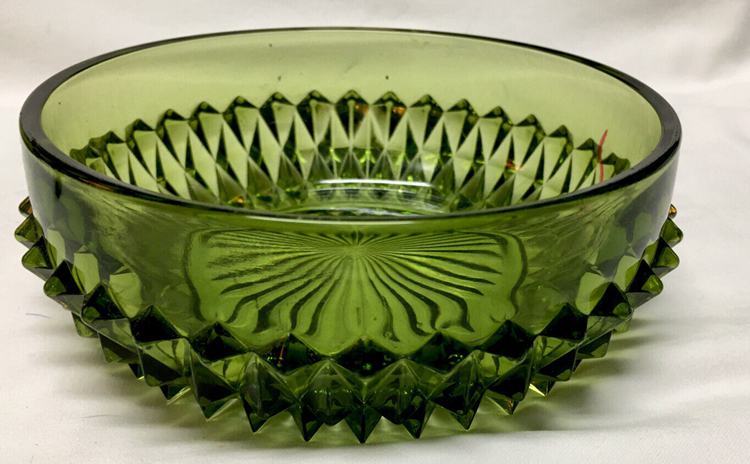
This is also one of the most common and easily recognized crystal designs. It is featured on practically every form of crystal glassware and consists of a series of little diamonds grouped in a repeating pattern throughout the item.
Many different firms, including Anchor Hocking and Tiffin, made this design.
The Scroll Pattern
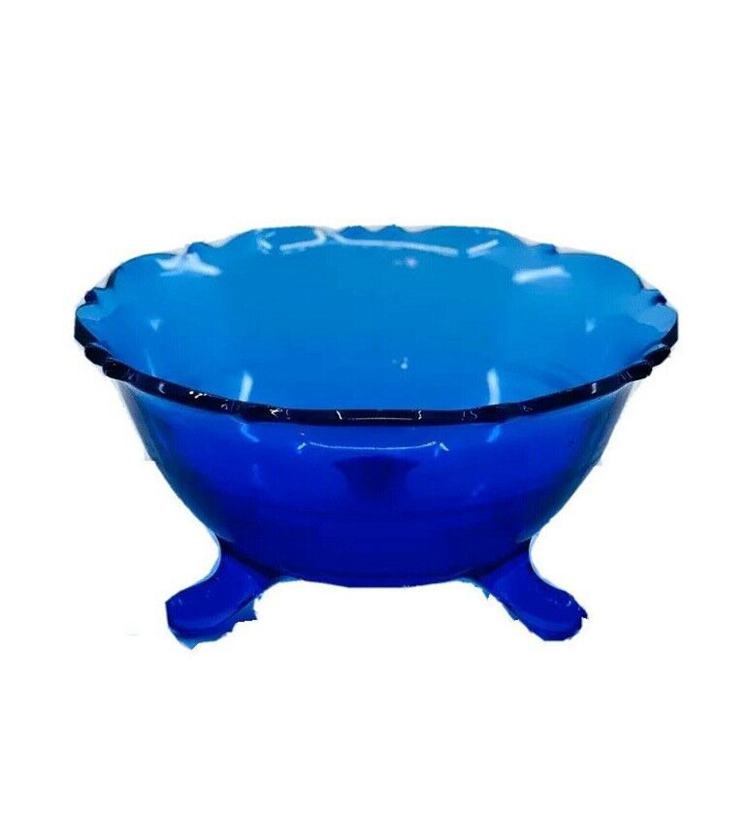
This design is made up of multiple different lines that are curled multiple times throughout. It’s dubbed “the scroll” because those lines resemble unfolding scrolls.
Imperial, Tiffin, and Westmoreland were among the businesses that produced this design.
The Thumbprint Pattern
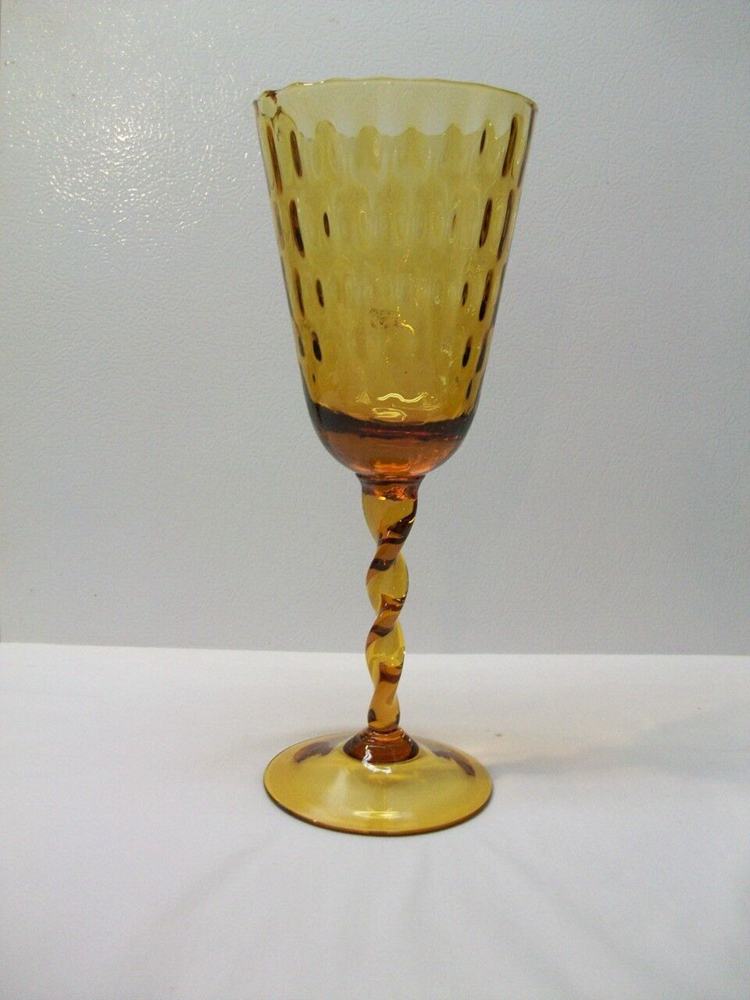
This design initially originated at the beginning of the nineteenth century and may be seen on almost any form of glassware, including the crystal. It has a series of little indentations that repeat in a random pattern.
The pattern’s name derives from the fact that the indentations appear to be the result of someone pressing their finger into the glass while it was still hot, creating a “thumbprint.”
Many crystal glass makers, including Imperial, Fostoria, and Westmoreland, produced this design.
The Star Of David Pattern
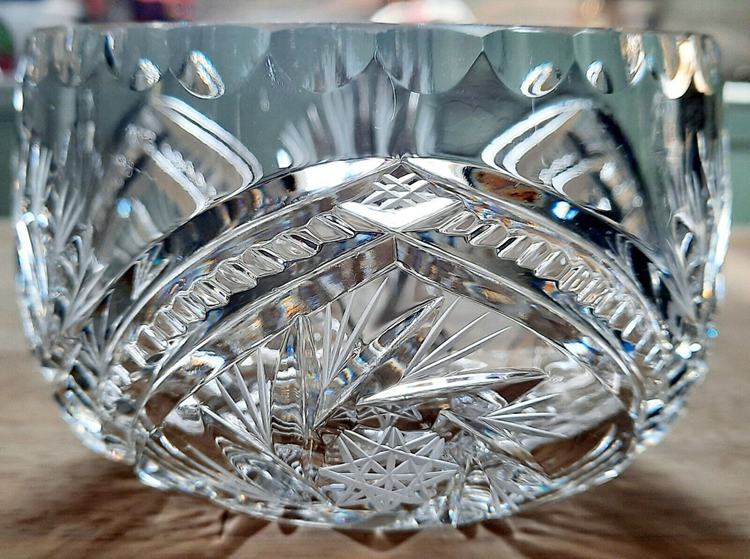
This design is easy to spot if you know what the Star of David looks like. It has two overlapping triangles that form a 6-pointed star, the Jewish sign.
Remember that each maker added their spin to this pattern, and some stars have more points and are positioned in different patterns throughout the piece.
Some crystal producers, such as Imperial and Tiffin, created this design.
Crystal Glassware Manufacturer Marks
Markings may be seen on a wide range of Crystal glassware. Use a magnifying glass or a mirror to assess the type of mark.
- The mark can be found on the bottom of the bowl as well as the center or rim of the glass’s foot or stem.
- A trademark might be a logo, coded numbers, characters, a phrase, or an initial.
- Some marks are engraved, while others are sculpted into the glass.
- Simply place a piece of paper on top of the glass and rub it with a pencil if you can’t see the mark. This makes it possible for you to read it.
- Markings from the manufacturer may be visible on inkspot antiques or magnificent glass.
If you still can’t figure out who manufactured it, don’t worry since you can recognize Crystal glassware designs to estimate how valuable your inheritance is.
Since producing Crystal glassware was also acknowledged as an art form, most makers used distinctive designs.
You may track your Crystal glassware back to the maker if you can identify the patterns.
- Crystal glassware might have pattern names inscribed on it.
- You should also pay attention to the pattern’s design.
- You may undoubtedly discover photographs of crystal glassware that appear similar to yours on Google or Pinterest because we can access all kinds of information through the internet.
- Free identification services, such as replacements, are available.
How Can You Tell The Worth Of Your Crystal?
Crystal glassware resembles ordinary glass, however, the distinction is that it is made of lead and is of greater quality than regular glass. Lead glasses are another name for crystal glasses.
Continue reading to learn about the history of Crystal glassware and how to identify its value by recognizing various factors.
Do you want to know how much antique Crystal glassware you recently purchased is worth? Or perhaps you have an insane amount of Crystal glasses that have been passed down through generations in your family and want to know their worth?
If you’re like most people, you probably have a few expensive objects laying about your house that you’re not sure how much they’re worth. Some antique crystal pieces are worth thousands of dollars, so get them evaluated.
You might be sitting on a fortune and not even realize it. The most important factors influencing the value of your crystal are as follows:
Rarity
Pieces with unique designs are constantly in high demand. Nobody is going to pay top dollar for a pattern that can be obtained at every thrift store in town.
Only the most expensive and intricate patterns are valued by hundreds of dollars.
Manufacturer
Some crystal firms were better recognized than others. Pieces produced by well-known manufacturers are always more valuable than those produced by lesser-known competitors.
Some of the most expensive jewels have been made by Waterford and Baccarat, for example.
History
A piece of crystal with a lengthy and outstanding history will always be valued more than one with no history.
If you can date your artwork and link it to a notable event or person, you will considerably increase its value.
Condition
The state of an object, like with other antiques, is one of the most important elements in evaluating its worth.
Crystal objects in perfect condition are the most precious, and even minor flaws can significantly lower their value.
Even the rarest and most valuable crystals aren’t worth much if they’re broken, shattered, or otherwise damaged.
Demand
Certain crystal designs are more popular than others. If you have a piece with a popular design that is now in demand, it will be worth more than one with little collector interest.
Quality
The value of a crystal is also affected by its quality. Pieces made of lead crystal will be more valuable than those made of soda-lime glass.
It’s partly because lead glass precedes soda-lime glass, therefore they’re older by default.
Age
Lastly, the general rule for all antiques is that the older the object, the more expensive it is likely to be. It’s because older crystals are more difficult to find, and most of them were destroyed over time.
The most unique vintage crystals cost between $1000 and $4000.
- Waterford crystal glassware is the most valued since it was the first company to produce crystal glasses. Collectors are drawn to the prism-shaped stems and sparkling patterns as well. They are priced between $1000 to $4000.
- Antique Baccarat crystal glassware is likewise in high demand. Some of this firm’s most basic designs might cost up to $3500.
- Swarovski also produces some of the most coveted antique crystal glasses.
You may get a fair sense of the costs of antique crystal glassware by searching eBay.
For example, Baccarat Malmaison Water Goblet Clear Crystal Cut Glass Is presently advertised for $900.
A single item, like Huge Val St Lambert Green Gold, Cut Crystal Centerpiece Bowl, can cost up to $1000. So go through your cabinets and see what treasures you may unearth!
How to Take Care of Your Antique Glass
Here are some helpful hints for caring for and cleaning your vintage and antique glass items.
First, you must understand how to care for your vintage glass. When using a glass vessel, do not let the water sit for days.
Long-standing foggy water rings are difficult to remove, so if you’re using an antique vase, make sure to change the water every two days to protect your vessel and keep your flowers prospering.
A nice consistent cleaning strategy is to wipe off your glass with distilled water regularly.
Avoid immersing and soaking fine antique glass in water, and keep the water you use at room temperature or slightly warm.
Avoid high temperatures, dishwashers, strong detergents, and high-pressure water while cleaning and storing dedicated glass.
When cleaning your glasses, use a plastic bowl instead of a sink because it is very simple to knock the glass against the taps.
Cover the area with a soft cloth or towel, and have a cushioned surface nearby in case you drop or tip a piece. If you’re a heavy-handed person, the more towels you have, the better.
To avoid glass breaking when subjected to abrupt temperature fluctuations, always use lukewarm water. Simply combine one drop of detergent per liter of water and clean one object at a time.
To remove dirt, use a cotton wool ball or a lint-free cloth to wipe the surface.
To prevent removing the gilding or ornamentation off ornamented glasses and decanters, use a bottle brush to go down into the small neck of a bottle and scrub the bottom thoroughly.
Rinse the glass object with clean water by dipping it into a basin of lukewarm water or wiping it with a moist wipe.
Blot dry with paper towels and leave the interior to dry for several hours by carefully holding the object upside down.
Removing Cloudy Rings
Cloudy glass is caused by calcium deposits, which give a light, foggy look to glass and are difficult to remove.
To remove the foggy water stains from the glass, soak it overnight in a natural solution of white vinegar and water to free the calcium. After rinsing, pat dry.
If the vinegar does not help, try applying petroleum jelly to the affected regions within the glass. Allow for 5 days before removing.
Cleaning Antique Glass Bottles
If your antique glass bottle has considerable staining and water damage, it may require a more vigorous cleaning session to be restored to good condition. Avoid using thin, delicate glass for this operation.
- Soak your bottles in water for a few minutes to dissolve the dirt and particles.
- You may also season with salt, the coarser the better.
- Shake the bottle and rinse it with dishwashing liquid and warm water.
- If done several times, this should work well for surface dirt.
- After the initial rinse, clean the dirt with various sizes of bottle brushes.
You now understand how to clean antique and vintage glass and bottles. We hope you find these cleaning ideas useful in reviving your vintage glass.
Where Can You Buy Antique Crystal Glassware?
There are several sites where you may purchase quality antique crystal glassware. They are as follows:
Antique shops in the neighborhood
- Thrift shops
- Etsy
- eBay
- Ruby Street
- OfferUp
- eBid
- Craigslist
Conclusion
From the 18th century to the present day, antique glassware has seen a succession of declines and booms. To make sure you get the correct collectibles, you need to know about their makers and qualities.
We have conducted extensive research to give you all of the knowledge you will require to make the best choices!





![Where To Sell Antique Furniture In 2022 [Ultimate Guide]](https://www.jacquelinestallone.com/wp-content/uploads/2022/09/Etsy-Your-Place-To-Buy-And-Sell-All-Things-Handmade-600x450.jpg)


